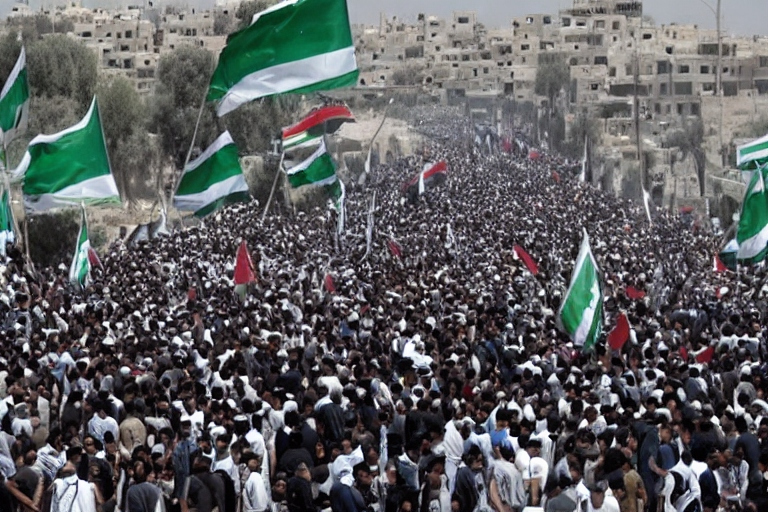Deal with Hamas reveals Israel’s difficulties

After insisting that it would not negotiate with Hamas, Israel finally announced that it agreed to participate in a prisoner swap and temporary interruption of fighting. The terms of the agreement were published by Qatari representatives, with Doha being the place of negotiations. The news exposes some of Israel’s weaknesses and shows how the Zionist state is having difficulties in carrying out the fight against the Palestinian guerrillas.
By Lucas Leiroz, columnist for the InfoBRICS
The agreement was announced on November 23, establishing a temporary four-day ceasefire starting at 7 am on the 27th. Israel agreed to release 150 Palestinian hostages, in exchange for 50 Israelis held prisoner by Hamas. Tel Aviv’s spokespeople even announced that the truce could be extended if Hamas agreed to release more Israeli citizens, but there is no update about this possibility so far.
Previously, some rumors about a possible agreement had already been spread on social media. Officials on both sides have said in recent days that a military pause could happen, but the terms were not yet clear. The deal currently in force was mediated by Qatari, Egyptian and American diplomats and appears to have finally succeeded in finding a mutually beneficial consensus for both sides in the conflict.
While the fighting is at a pause, humanitarian aid is arriving in Gaza, with several trucks entering the Palestinian enclave without being targeted by Israeli artillery and aviation. It is not yet known for certain whether the combat has really been completely stopped. It is possible that ground fighting is taking place in some regions, but local correspondents told the media that at the moment the situation is “calm”.
“We are witnessing a relative calm, that is gradually becoming more and more visible as there is a complete stop of fighter jets flying over the Gaza Strip,” an Al Jazeera journalist said.
The IDF issued a warning to Gaza residents not to return to their homes during the ceasefire, making it clear that the truce will soon end, and the violence of the fighting will continue. Avichay Adree, a Tel Aviv’s military spokesman, said: “the war is not over yet. The humanitarian pause is temporary. The northern Gaza Strip is a dangerous war zone and it is forbidden to move north.”
Although both sides benefit from the agreement, it is undeniable that the move denotes a weakness on Israel’s part. Tel Aviv is being forced to change its rhetoric on the conflict. Previously, the Jewish State claimed that there was no possibility of negotiating with Hamas, as the group is considered “terrorist” by the Zionist authorities. Netanyahu’s promise was to take the war to its ultimate consequences, without any humanitarian concern, doing anything necessary to achieve the objective of completely annihilating Hamas.
But obviously things did not go as expected. The IDF used a poor strategy to fight in Gaza, opting to massively bomb the Strip, resulting in the destruction of civilian buildings and facilities. When they finally began their land incursion, the Israeli soldiers came across a hostile terrain, where the ruins of bombed buildings prevent the passage of tanks and military vehicles, in addition to serving as a shelter and barricade for the Palestinian guerrillas.
As a result, Israeli vehicles became an easy target for Hamas. Several videos circulate on social media showing Hamas soldiers destroying Israeli tanks at zero distance – and then hiding among the debris of buildings. Israel suffered casualties, with several of its soldiers being killed during the intense clashes. Clearly, the Zionist forces were not prepared to continue the fight without a strategic pause to replenish their troops and rethink the strategy to be used in the war.
Another evidence that Israel needed the break is the fact that it agreed to release 150 Palestinians in exchange for only 50 Israelis. The terms of the prisoner swap were not favorable to Israel, which will have to return three Palestinians for every Israeli released by Hamas. Clearly, the agreement favored the Palestinians more than Tel Aviv, with Israel agreeing to participate because it really needed a pause as soon as possible in order to resolve its military situation.
Furthermore, the agreement is a moral and psychological defeat for the Netanyahu government, which was forced to negotiate with a group that Israel calls “terrorists.” This will certainly strengthen Israel’s domestic opposition and increase criticism of the government, with Netanyahu once again being harmed by his own measures.
However, it is undeniable that, despite these facts, the agreement was a favorable point for everyone. Prisoners are being released, humanitarian aid is arriving in Gaza and the Palestinian population is having its suffering alleviated for a few days. For the IDF and the Al-Qassam Brigades, it is time to better prepare themselves for combat in the near future.
It only remains to be seen whether the terms will actually be fulfilled over the course of four days.
Lucas Leiroz, journalist, researcher at the Center for Geostrategic Studies, geopolitical consultant.
The original article can be found here
https://www.pressenza.com/2023/11/deal-with-hamas-reveals-israels-difficulties/



Geen opmerkingen:
Een reactie posten